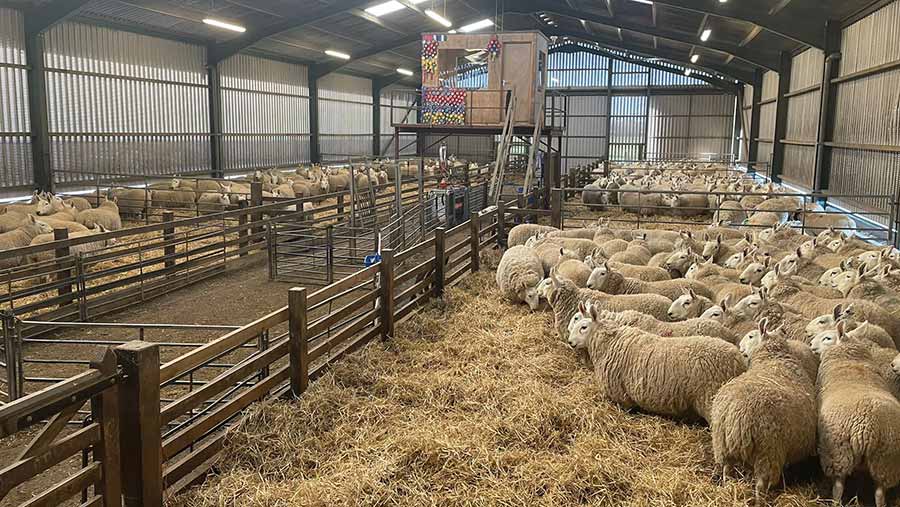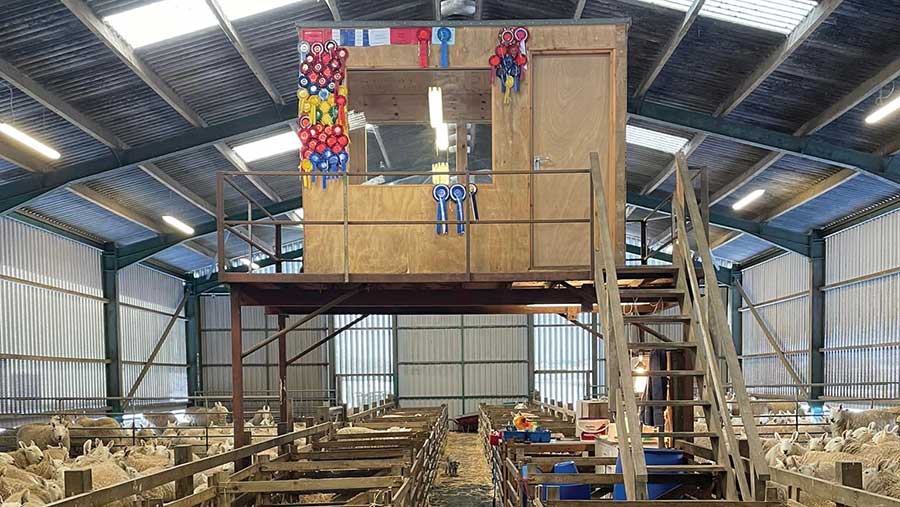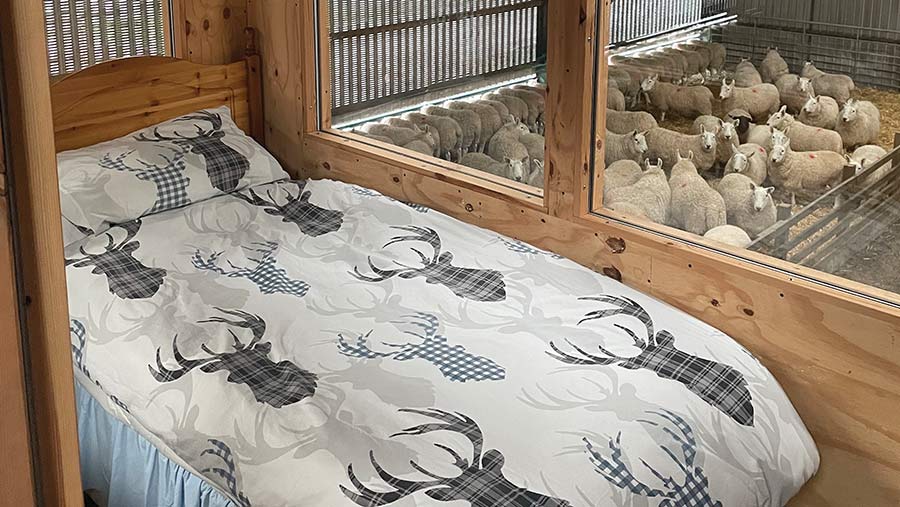Purpose-built hut reduces lambing intervention on mixed farm
 © Lorna Shaw
© Lorna Shaw A purpose-built hut set on a raised platform in the centre of the lambing shed is proving the ideal solution for a father and son to keep a careful eye on their flock in the Scottish Borders.
As well as providing a warm and comfortable place for staff to rest at night, it has minimised the amount of intervention during lambing at Smailholm Mains, near Kelso.
See also: Lambing shed communication – why and how to improve it
Farm facts: Smailholm Mains, near Kelso
- 243ha mixed farm with arable, beef and sheep
- Rotational grass leys and 40ha permanent pasture
- 505 ewes – 50 pure Suffolks and 450 Scotch Halfbreds
- Lambing indoors in January and March
- Total mixed ration at lambing consisting of silage, home-grown barley and rapeseed meal
- 85 suckler cows plus followers
- Home-bred Suffolk tup lambs used on Halfbreds before being sold at Kelso market
- Small amount of arable contract work
Lambing takes place in one shed on the 243ha (600-acre) mixed farm run by Stewart Shaw and his father, Alan, in partnership with Alan’s brother Ron. Sheep are brought in six weeks before lambing, and those carrying triplets two weeks earlier.
The sheep are sorted into six pens – three either side of a central passage – according to the number of lambs they are carrying. Fifty pure Suffolks and 100 Scotch Halfbreds lamb in January. The shed is then mucked out before the remaining 350 Halfbreds lamb in March, over a three-week period. Lambing gates are hinged with wires and wooden droppers to allow easy access and make it easy to dismantle for disinfection between lambings.
Hut particulars
During lambing, a 1.8x3m hut is raised 2.4m above the floor over the central passage. It sits on a platform made from an old trailer flatbed measuring 2.4×4.3m, leaving room for a walkway on three sides of the hut. Repurposed portacabin stilts provide a framework for the platform. Steps lead up to the hut, and underneath is a sink – installed previously to serve the lambing shed – and a race and handling pen.
🐑 💤 A purpose-built hut set on a raised platform in the centre of the lambing shed is proving the ideal solution for a father and son to keep a careful eye on their flock in the Scottish Borders.
READ MORE: https://t.co/hNeXXSoPbk pic.twitter.com/wiyRdVz17t
— Farmers Weekly (@FarmersWeekly) February 14, 2024
The hut was built by a local joiner at a total cost of £2,000 (the flatbed trailer had been lying unused in the farmyard). It is insulated and fitted with double-glazed windows (because they were cheaper than single glazing) on four sides. Inside, there is a bed, an electric heater and a television. While food could be prepared, Stewart says the hut is primarily a quiet place to rest, not to eat extra meals.
The Shaws had seen other lambing sheds with a caravan or cabin placed in a corner or at one end, but putting their hut in the middle of the shed provides all-round vision of their sheep, says Stewart.

© Lorna Shaw
Labour cost
The need for a hut came about when a neighbouring farm, which the Shaws contract-farmed, was sold, and they lost the contract. They had been employing a night lamber at Smailholm Mains, who would use a small office in the old lambing shed to warm up and take breaks. The arrangement helped with labour demand at that time of year, but without the contract work, it was harder to justify the cost.
Then the night lamber fell ill at the start of lambing, and Stewart had to take over. After a year or two with this arrangement, he and Alan decided a “night-about” system might be easier for them to manage. With this system, instead of Stewart working every night and being off during the day, they both work every day and cover alternate nights. Rather than working right through the night, however, the aim is to monitor the flock periodically and intervene as little as possible.
To begin with, they walked back and forth from their homes (next door to each other), 200 yards from the lambing shed. While not a big distance, it was still disruptive, Stewart says. “We would walk up to the shed, switch on the lights, which would disturb the sheep. We’d see one lambing but not know how long it had been going on, and do a lot more intervention.”
Cameras that could be monitored from the house were considered, but Stewart says they realised this would still mean walking up to the shed whenever there was a problem.

© Lorna Shaw
Watching from bed
“We came to the conclusion that, rather than having cameras, if we could stay in the shed and have somewhere to lay down, relax and switch off – but also be there to watch a problem – it would improve our working environment,” he says.
“Cameras are fantastic and something we’re thinking we might still invest in for the start and finish of lambing. But when you’re in the thick of it, you can be lambing 20 a night – we have a high lambing percentage and don’t want to miss [any]. If you’re there [in the hut], lying in bed, you know what’s going on and it’s really easy to watch without intervening, unless there’s a serious problem.”
For this year’s January lambers, scanning rate was 160% for the Suffolks and 180% for the Halfbreds. The March flock scanned at 200%. Stuart says: “When you take out the empties, what has come into the shed for March lambing is 212%, so we’ll have a lot of lambs. We had good grass growth at the back end [of last year].”
He says they are now more likely to intervene in the daytime to ease workflow between routine lambing tasks and other jobs on the farm such as feeding the cattle.
Warmer than home
Although the system means working long hours – Stewart says this is possible using family labour, but he would never ask an employee to work a 36-hour shift – overall, the hut has improved working conditions too. Even on the coldest January night, at -8C, the hut is cosy and comfortable, and “certainly warmer than the farmhouse”.
“How much sleep we get depends on the sheep, but we get as much rest as possible. It’s very manageable for a system our size – we’re not lambing 1,000 ewes, so there’s not something happening constantly through the night.
“I think it would work on a bigger scale, though, and hopefully we’ll continue to grow our operation and put it to the test,” he says.
